Common plastic molding process
Plastic is an indispensable raw material in life, and different products can be made through different molding processes. Our common plastic packaging boxes, plastic trays, plastic cups, etc. are all plastic raw materials made of plastic sheets through extrusion and calendering processes. Common PP plastic sheets, PET plastic sheets, PS plastic sheets, EVOH composite plastics sheet etc. These plastic sheets are then made into packaging boxes, trays, mineral water bottles and other products through thermoforming blister and blow molding processes. Let's take a look at the plastic molding process.
1. Extrusion (profile)
Extrusion molding: Also known as extrusion molding, it is mainly suitable for the molding of thermoplastics, and also suitable for the molding of some thermosetting and reinforced plastics with good fluidity. The molding process is to use the rotating screw to extrude the heated and melted thermoplastic material from the die head with the desired cross-sectional shape, then shape it by the shaper, and then pass it through the cooler to make it harden and solidify to become the desired cross-sectional shape. product.
Process features:
1. The equipment cost is low.
2. The operation is simple, the process is easy to control, and it is convenient to realize continuous automatic production.
3. High production efficiency, uniform and dense product quality.
4. Products or semi-finished products with various cross-sectional shapes can be formed by changing the die of the die.
Application:
In the field of product design, extrusion molding has strong applicability. The types of extruded products include pipes, films, rods, monofilaments, flat belts, nets, hollow containers, windows, door frames, sheets, cable cladding, monofilaments and other profiles.
2. Calendering (sheet, film)
Calendering: It is a method in which plastic raw materials pass through a series of heated rollers to form a film or sheet under the action of extrusion and extension.
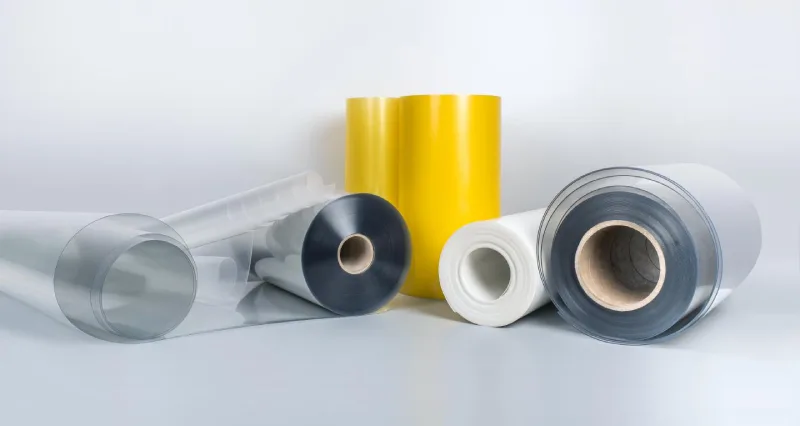
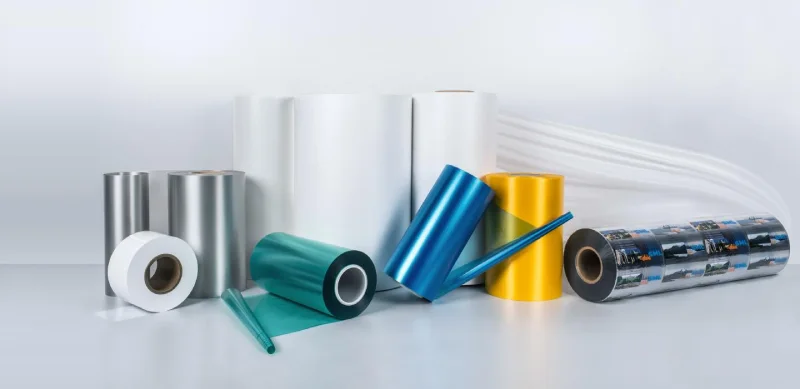
Process features:
Advantages: good product quality, large production capacity, automatic continuous production.
Disadvantages: The equipment is huge, the precision is high, the auxiliary equipment is many, and the width of the product is limited by the length of the roller of the calender.
Application:
It is mostly used in the production of PVC soft film, sheet, sheet, artificial leather, wallpaper, floor leather, etc.
3. Blow molding
Blow molding: The molten thermoplastic raw material extruded from the extruder is clamped into the mold, and then air is blown into the raw material. The molten raw material expands under the action of air pressure, fits to the wall of the mold cavity, and finally cools. The method of curing into the desired product shape.
Blow molding is divided into film blow molding and hollow blow molding.
1. Film blow molding
Film blow molding is to extrude molten plastic from the annular gap of the extruder die into a cylindrical thin tube, and at the same time blow compressed air into the inner cavity of the thin tube from the center hole of the die to inflate the thin tube to a diameter A larger tubular film (commonly known as a bubble tube), which is coiled after cooling.
2. hollow blow molding
Hollow blow molding is a secondary molding technology that inflates a rubber-like parison closed in a mold cavity into a hollow product by means of gas pressure, and is a method for producing hollow plastic products. According to the different manufacturing methods of the parison, hollow blow molding includes extrusion blow molding, injection blow molding, and stretch blow molding.
1) Extrusion blow molding: Extrusion blow molding is to use an extruder to extrude a tubular parison, clamp it in the mold cavity and seal the bottom while it is still hot, and then blow compressed air into the inner cavity of the tube blank for inflation.
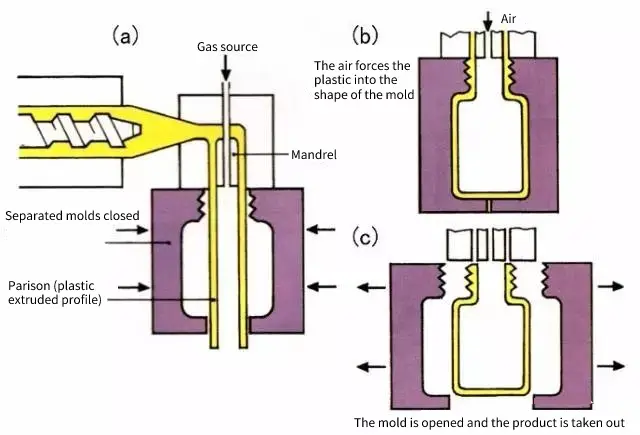
2) Injection blow molding: The parison used is obtained by injection molding. The parison is left on the core mold of the mold. After the blow mold is used to close the mold, compressed air is introduced into the core mold to inflate and cool the parison. After demolding, the product is obtained.
Advantages: The wall thickness of the product is uniform, the weight tolerance is small, the post-processing is less, and the waste corners are small. It is suitable for the production of small refined products in large batches.
3) Stretch blow molding: The parison that has been heated to the stretching temperature is placed in the blow mold, longitudinally stretched with a stretching rod, and transversely stretched with blown compressed air, so as to obtain the product's method.
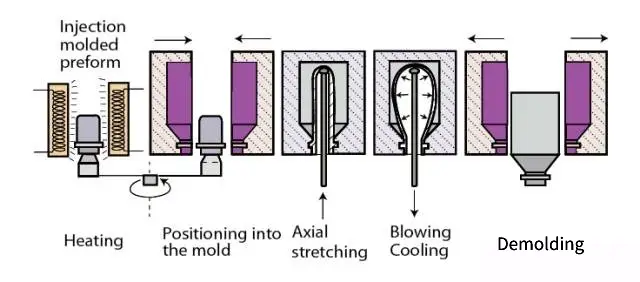
Application:
1. Film blow molding is mainly used to manufacture thin plastic molds.
2. Hollow blow molding is mainly used to make hollow plastic products (bottles, packaging barrels, watering cans, fuel tanks, cans, toys, etc.).
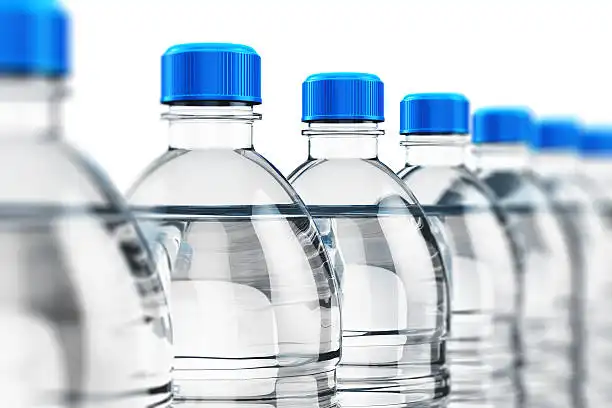
4. Blister molding
Blister forming: Also known as vacuum forming, it is one of the thermoforming methods of thermoplastics. It means that the sheet or plate material is clamped on the frame of the vacuum forming machine, and after heating and softening, it is adsorbed on the mold by vacuum through the air channel on the edge of the mold, and after a short period of cooling, the molded plastic product is obtained.
Classification:
Vacuum forming methods mainly include concave mold vacuum forming, punch vacuum forming, concave and convex mold vacuum forming successively, bubble blowing vacuum forming, plunger push-down vacuum forming, vacuum forming with gas buffer device, etc.
advantage:
The equipment is relatively simple, the mold does not need to be under pressure, and can be made of metal, wood or gypsum. The molding speed is fast and the operation is easy.
Application:
Widely used in internal and external packaging of food, cosmetics, electronics, hardware, toys, crafts, medicine, health products, daily necessities, stationery and other industries. Disposable cups, various cup-shaped cups, etc. Breeding trays, seedling trays, degradable snack boxes.
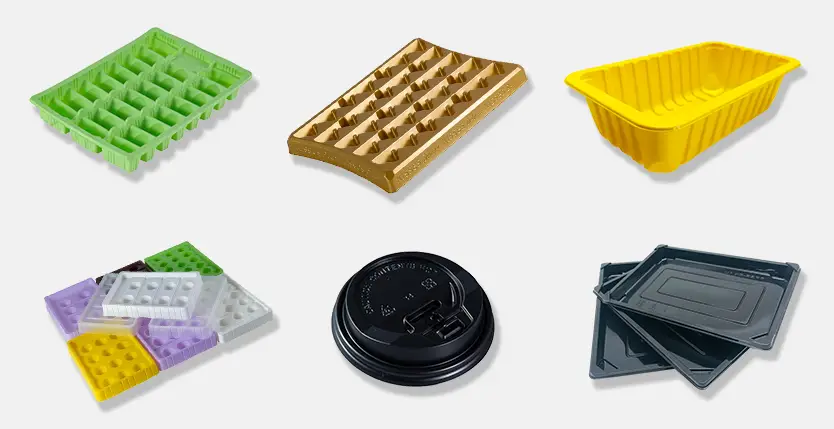
PULIXIN is an excellent plastic sheet manufacturer in China, we mainly produce PET plastic sheet, PS plastic sheet, PP plastic sheet, EVOH composite plastic sheet, PE plastic sheet and so on. Through the thermoforming blister process, etc., food trays, packaging boxes, etc. can be made, which are widely used. If you are looking for high quality and reliable plastic sheet suppliers, you are welcome to contact us at any time, we will be your loyal partner.
Relative News
- Why can ESD plastic trays protect electronic prod…
- How to choose between virgin PET sheet and RPET s…
- What kind of blister sheet can be used to make tr…
- Black conductive HIPS plastic sheet roll shipped …
- PULIXIN packaging materials unveiled at Chinaplas…
- PP blister sheet: an environmentally friendly, sa…
- PET blister sheet: transparent protection, fresh …
- PET plastic sheet rolls set sail to help upgrade …
- Key features of our HIPS plastic rolls
- The secret behind the yogurt box: revealing the s…
